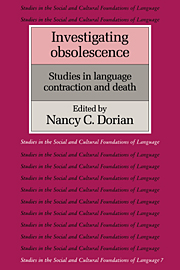Book contents
- Frontmatter
- Contents
- List of maps
- List of contributors
- Preface
- Map
- Dedication
- Introduction
- I Focus on context
- II Focus on structure
- III Invited commentaries
- 21 Some people who don't talk right: Universal and particular in child language, aphasia, and language obsolescence
- 22 Language obsolescence and language history: Matters of linearity, leveling, loss, and the like
- 23 Language convergence and language death as social processes
- 24 Pidgins, creoles, immigrant and dying languages
- 25 The “up” and “down” staircase in secondary language development
- Bibliography
- Index of languages
- General index
21 - Some people who don't talk right: Universal and particular in child language, aphasia, and language obsolescence
Published online by Cambridge University Press: 08 January 2010
- Frontmatter
- Contents
- List of maps
- List of contributors
- Preface
- Map
- Dedication
- Introduction
- I Focus on context
- II Focus on structure
- III Invited commentaries
- 21 Some people who don't talk right: Universal and particular in child language, aphasia, and language obsolescence
- 22 Language obsolescence and language history: Matters of linearity, leveling, loss, and the like
- 23 Language convergence and language death as social processes
- 24 Pidgins, creoles, immigrant and dying languages
- 25 The “up” and “down” staircase in secondary language development
- Bibliography
- Index of languages
- General index
Summary
Linguistics lacks a term more felicitous than “normal” for language in its optimal state of knowledge and use, i.e., language as it is commanded by native (mono- or multilingual) speakers in full possession of adult intelligence, social skills, language processing abilities, etc. But we need a way to refer to this unmarked case, one which does not invite the kind of confusion between the state of the speaker and the state of his/her language abilities which arises from the use of the term “normal” language. I propose to call this optimal state “full” language: this is to be distinguished from the abstract notion of “ideal” language, since “full” language is intended to denote a normal range of lects and modalities; thus it is not homogeneous within or across speakers, nor devoid of metaphor, archaism, or the like.
The label “full” encodes our sense that language which has been learned and/or deployed under various less-than-optimal circumstances is simpler and poorer than “full” language. In the first section of this discussion chapter, I offer some comments on the notion of “simplicity” as it applies to child language and aphasic language, comparing it with the kinds of simplification in the contracted manifestations of language reported in the present volume. This volume in fact demonstrates that a rich set of dimensions of variation, rather than a unidimensional (implicational) simplicity hierarchy, will be required for the characterization of potential universals in the case of language contraction. In particular, we have seen that degrees and differing circumstances of original acquisition and conditions of subsequent use/disuse appear to have important effects on the patterns of the contracted language, as already suggested by Dorian (1982c).
- Type
- Chapter
- Information
- Investigating ObsolescenceStudies in Language Contraction and Death, pp. 335 - 346Publisher: Cambridge University PressPrint publication year: 1989
- 7
- Cited by



